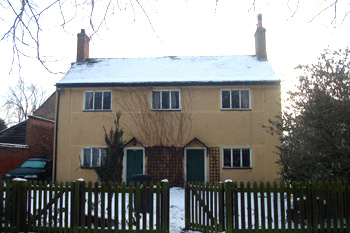
323 and 324 Church Lane Christmas Eve 2010
323 and 324 Church Lane were listed by the former Ministry of Public Buildings and Works in July 1964 as Grade II, of special interest. The ministry dated the properties to the 18th century. They are built of colour washed roughcast and have old clay tiled roofs
We are fortunate that three surveys of the parish of Cardington from the late 18th century survive. The first of these was undertaken in 1782 by James Lilburne. He was the parish schoolmaster and later agent for Samuel Whitbread, who owned large estates in the parish and also the sole Enclosure Commissioner for the parish. He produced a list of all the inhabitants of the parish arranged by house and hamlet [P38/28/1]. This was published, with extensive analysis by County Archaeologist David Baker in 1973 as Bedfordshire Historical Record Society Volume 52.
Since publication a second list has been found [P38/28/2]. It carries revisions up to the year 1789. Sadly neither of these surveys includes a map. Finally, in 1794 Lilburne produced another survey [W2/6/1-3] and this one had a map with a key showing where each house was. One can use this to plot the houses of the previous surveys and this work was carried out by John Wood of Bedfordshire County Council’s Conservation Section in October 1982 [CRT130Cardington29].
The 1782 survey describes this premises as a cottage divided into two tenements [P38/28/1/2]. One side was occupied by Robert Castleman, aged 31, a bricklayer who had been born in Renhold. He was a dissenter, that is, a nonconformist in his religious views. His wife was 35 year old Sarah, née Crouch, who had been born at “Hendlow”, i. e. Henlow. She was a Mantua maker, in effect a dressmaker. They had two children. Elizabeth was aged 8 but, sadly she died on 5th December 1784 “after losing her leg”. She would then have been ten or eleven years old. Francis was aged 6 and received schooling at the expense of John Howard. His entry is annotated: “Sings”. The whole family with the exception of Elizabeth had had smallpox before May 1787.
The other half of the building was in the occupation of John Redman, a 45 year old labourer who had been born in Cardington. His wife was 31 year old Mary, née Crouch, who had been born at Henlow. It seems reasonable to assume that she was the sister, or some other close relative, of Sarah Castleman next door. She, too, was a Mantua maker. The couple had two children at the time. Sarah was 12 but, sadly, she died on 22nd October 1782. She had been schooled courtesy of Samuel Whitbread. She had a brother, Samuel, aged 9 who was schooled at the expense of John Howard. His entry is annotated: “Sings”. A third child, Mary, was born on 7th May 1785. The couple also had 75 year old Sarah Redman, widow, presumably John’s mother, living with them. She died on 5th October 1787. Sarah had had smallpox before May 1787 and the rest of the family were willing to be inoculated against it if others in the village were. In 1794 the same two families were living in their respective tenements [W2/6/1-3].
The Rating and Valuation Act 1925 specified that every building and piece of land in the country was to be assessed to determine its rateable value. Cardington, like most of the county, was assessed in 1927 and the valuer visiting 323 and 324 Church Lane [DV1/C116/12-13] found them owned by the Whitbread Estate.
Number 323 was occupied by Mrs. Caves who paid rent of £3/13/8 per year for a living room, scullery, “place with copper” (for heating water) and one bedroom. A wood barn stood outside. She was not at home when the valuer called.
Number 324 was in the occupation of S. R. Jeakins whose rent was included in his wages as he worked for the Estate. His accommodation also comprised a living room and scullery, place for a copper and one bedroom. Again, a wood barn stood outside.